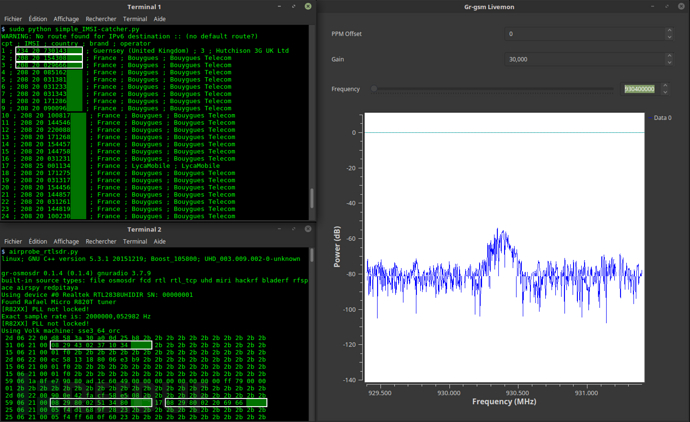IMSI-catcher:可發現附近手機敏感資訊的工具
嚴正宣告:該工具主要是為了讓大家更好的瞭解GSM網路的工作原理而設計開發的,請不要用於惡意目的!
前言
IMSI-catcher是一個可以幫助你發現附近手機的IMSI號碼,國家,品牌和運營商等資訊的工具。
你需要準備的裝置
一臺PC電腦
1個帶有天線的USB DVB-T key(RTL2832U)(大概在15美元以內),或是一部OsmocomBB手機一個HackRF裝置。
設定
git clone https://github.com/Oros42/IMSI-catcher.git
# or wget https://github.com/Oros42/IMSI-catcher/archive/master.zip && unzip -q master.zip
sudo apt install python-numpy python-scipy python-scapy 對於Debian Testing (10) 和 Ubuntu 18.04+ gr-gsm 的安裝,請參閱:https://osmocom.org/projects/gr-gsm/wiki/Installation
對於老版本的Debian 和 Ubuntu的安裝命令如下 :
sudo add-apt-repository -y ppa:ptrkrysik/gr-gsm
sudo apt update
sudo apt install gr-gsm如果gr-gsm設定失敗,請參照:https://github.com/ptrkrysik/gr-gsm/wiki/Installation 進行設定。
Debian:https://tracker.debian.org/pkg/gr-gsm
執行
使用舊版本的gr-gsm
開啟2個終端。
在終端1中輸入:
sudo python simple_IMSI-catcher.py --sniff你可以新增-h引數顯示可用選項。
在終端2中,搜尋頻率:
grgsm_scanner使用grgsm_livemon命令嗅探你搜索到的頻率:
grgsm_livemon -f <your_frequency>M例如:
grgsm_livemon -f 938.2M執行後應該會產生類似以下輸出:
15 06 21 00 01 f0 2b 2b 2b 2b 2b 2b 2b 2b 2b 2b 2b 2b 2b 2b 2b 2b 2b
25 06 21 00 05 f4 f8 68 03 26 23 2b 2b 2b 2b 2b 2b 2b 2b 2b 2b 2b 2b
49 06 1b 95 cc 02 f8 02 01 9c c8 03 1e 57 a5 01 79 00 00 1c 13 2b 2b
...你可以根據需求更換不同的頻率。
gr-gsm >= 0.41.2-1
同樣,開啟2個終端。
在終端1中輸入:
python simple_IMSI-catcher.py你可以新增-h引數顯示可用選項。
在終端2中輸入:
python scan-and-livemon這個過程可能需要幾分鐘的時間。因為,它需要執行grgsm_scanner來查詢附近的基站,並請求grgsm_livemon_headless接收訊號。
或是先找到附近基站的頻率。
grgsm_scanner接著,使用grgsm_livemon命令嗅探你搜索到的頻率:
grgsm_livemon -f <your_frequency>M例如:
grgsm_livemon -f 938.2M執行後應該會產生類似以下輸出:
15 06 21 00 01 f0 2b 2b 2b 2b 2b 2b 2b 2b 2b 2b 2b 2b 2b 2b 2b 2b 2b
25 06 21 00 05 f4 f8 68 03 26 23 2b 2b 2b 2b 2b 2b 2b 2b 2b 2b 2b 2b
49 06 1b 95 cc 02 f8 02 01 9c c8 03 1e 57 a5 01 79 00 00 1c 13 2b 2b
...你可以根據需求更換不同的頻率。
完成以上操作後,下面我們要做的就是等待結果。大概一分鐘左右的時間,我們就能夠在終端1中看到IMSI號碼。如果一分鐘後沒有出現任何內容,那麼請更改你的頻率。
相關文件:https://fr.wikipedia.org/wiki/Global_System_for_Mobile_Communications
例如法國的頻率為:9.288e+08 Bouygues
檢視捕獲到的資料包:
sudo wireshark -k -Y '!icmp && gsmtap' -i lo可選項
獲取有關訊號塔的資訊:
sudo python find_cell_id.py獲取Immediate Assignment信令:
sudo python immediate_assignment_catcher.py查詢頻率
除了可以使用上面提到的grgsm_scanner來查詢頻率,你也可以使用像kalibrate-hackrf這樣的工具來查詢:
sudo apt-get install automake autoconf libhackrf-dev
git clone https://github.com/scateu/kalibrate-hackrf
cd kalibrate-hackrf/
./bootstrap
./configure
make
sudo make install執行
kal -s GSM900kal: Scanning for GSM-900 base stations. GSM-900: chan: 14 (937.8MHz + 10.449kHz) power: 3327428.82 chan: 15 (938.0MHz + 4.662kHz) power: 3190712.41參考資料:
Gr-Gsm 設定:https://github.com/ptrkrysik/gr-gsm/wiki/Installation
頻率:http://www.worldtimezone.com/gsm.html(https://fr.wikipedia.org/wiki/Global_System_for_Mobile_Communications)
MNC:https://en.wikipedia.org/wiki/Mobile_Network_Code
Scapy:http://secdev.org/projects/scapy/doc/usage.html
IMSI:https://fr.wikipedia.org/wiki/IMSI
Realtek RTL2832U:https://osmocom.org/projects/sdr/wiki/rtl-sdr(http://doc.ubuntu-fr.org/rtl2832u)http://doc.ubuntu-fr.org/rtl-sdr

